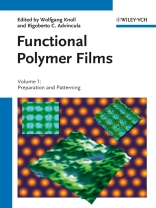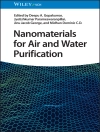Very thin film materials have emerged as a highly interesting and useful quasi 2D-state functionality. They have given rise to numerous applications ranging from protective and smart coatings to electronics, sensors and display technology as well as serving biological, analytical and medical purposes. The tailoring of polymer film properties and functions has become a major research field.
As opposed to the traditional treatise on polymer and resin-based coatings, this one-stop reference is the first to give readers a comprehensive view of the latest macromolecular and supramolecular film-based nanotechnology. Bringing together all the important facets and state-of-the-art research, the two well-structured volumes cover film assembly and depostion, functionality and patterning, and analysis and characterization. The result is an in-depth understanding of the phenomena, ordering, scale effects, fabrication, and analysis of polymer ultrathin films.
This book will be a valuable addition for Materials Scientists, Polymer Chemists, Surface Scientists, Bioengineers, Coatings Specialists, Chemical Engineers, and Scientists working in this important research field and industry.
Cuprins
Volume 1: Preparation and Patterning
PART I: Preparation
A PERSPECTIVE AND INTRODUCTION TO ORGANIC AND POLYMER ULTRATHIN FILMS: DEPOSITION, NANOSTRUCTURING, BIOLOGICAL FUNCTION, AND SURFACE ANALYTICAL METHODS
MULTIFUNCTIONAL LAYER-BY-LAYER ARCHITECTURES FOR BIOLOGICAL APPLICATIONS
Introduction
Drug Delivery and Lb L
Interaction of Cells with Lb L Films: Adhesion, Proliferation, Stimulation, and Differentiation
Plasmid DNA (p DNA)-Based Gene Therapy and Lb L Films
Exotic Applications of Lb L Inspired by Biology
THE LAYER-BY-LAYER ASSEMBLIES OF POLYELECTROLYTES AND NANOMATERIALS AS FILMS AND PARTICLE COATINGS
Layer-by-Layer (Lb L) Self-Assembly Technique
The Properties of Polyelectrolytes
Adsorption of Polyelectrolytes
Polyelectrolyte Multilayer Formation on Flat Surfaces
Polyelectrolyte Multilayer Formation on Colloidal Particles
Applications of Layer-by-Layer Films and Particles
Advincula Group Research on Layer-by-Layer Films and Particle Coatings
LANGMUIR-BLODGETT-KUHN ULTILAYER ASSEMBLIES: PAST, PRESENT, AND FUTURE OF THE LB TECHNOLOGY
Introduction
Historical Background
Basic Procedures and Characterization Methods
Types of Materials Used in Producing LB Films
Trends in Research Activity on LB Films
Highlights of Research in LB Films
Concluding Remarks
SELF-ASSEMBLED MONOLAYERS: THE DEVELOPMENT OF FUNCTIONAL NANOSCALE FILMS
Introduction
Historical Background for Monolayer Films
Self-Assembled Monolayer (SAM) Fundamentals
SAM Phenomena
Manipulation of Adsorbate Structure
Conclusions
POLYELECTROLYTE BRUSHES: TWENTY YEARS AFTER
Introduction – Scope of the Review
Definitions
How to Make Polyelectrolyte Brushes?
Simple Observations and Theoretical Concepts
Beyond Simplicity
Toward the Application of Polyelectrolyte Brushes
Conclusion
PREPARATION OF POLYMER BRUSHES USING ‘GRAFTING-FROM’ TECHNIQUES
Introduction to Polymer Brushes and Their Formation
Methods for Synthesis of Polymer Brushes
Surface-Initiated ATRP
Summary
ULTRATHIN FUNCTIONAL POLYMER FILMS USING PLASMA-ASSISTED DEPOSITION
Introduction
Choice of Precursors
Polymerization Mechanisms and Chemical Structure
Properties of Ultrathin Functional Plasma Polymers
Summary
PREPARATION OF POLYMER THIN FILMS BY PHYSICAL VAPOR DEPOSITION
Introduction
Overview of PVD of Polymers
Direct Evaporation of Polymers
Stepwise Polymerization by Coevaporation of Bifunctional Monomers
Radical Polymerization of Vinyl Monomers
Surface-Initiated Vapor-Deposition Polymerization
Conclusions
ELECTRO-OPTICAL APPLICATIONS OF CONJUGATED POLYMER THIN FILMS
Introduction
Properties of Organic Semiconductors and Conjugated Polymers
Synthetic Methods
Characterization Methods
Device Fabrication
Concluding Remarks
ULTRATHIN FILMS OF CONJUGATED POLYMER NETWORKS: A PRECURSOR POLYMER APPROACH TOWARD ELECTRO-OPTICAL DEVICES, SENSORS, AND NANOPATTERNING
Introduction
Materials and Examples
Conclusions
PART II: Patterning
NANOPATTERNING ND FUNCTIONALITY OF BLOCK-COPOLYMER THIN FILMS
Introduction
Nanoscale Patterning with BCPs
Functionality of BCP Thin Films
Summary and Outlook
PATTERNING BY PHOTOLITHOGRAPHY
Introduction
Deep-UV Lithography
193-nm Lithography
157-nm Lithography
193-nm Immersion Lithography
Next-Generation Lithographic Technology
Summary
NANOPATTERNING OF POLYMER BRUSH THIN FILMS BY ELECTRON-BEAM LITHOGRAPHY AND SCANNING PROBE LITHOGRAPHY
Introduction
Electron-Beam Lithography
Scanning Probe Lithography
Conclusions
DIRECT PATTERNING FOR ACTIVE POLYMERS
Introduction
Direct Photopatterning by Photocross-Linking
Direct Photopatterning by Photo-Oxidation
Direct Patterning by Photoinduced Acidification
Reversible Patterning
Conclusion
NANOPATTERNING OF PHOTOSENSITIVE POLYMER FILMS
Introduction
Nanofabrication by a Tightly Focused Laser Beam
Near-Field Nanofabrication beyond the Diffraction Limit of Light
Two-Photon Patterning
Conclusion
Volume 2: Characterization and Application
PART III: Characterization
DYNAMICS OF THERMOMECHANICS OF POLYMER FILMS
Introduction
Experimental Techniques
Dynamics
Thermomec
Despre autor
Wolfgang Knoll is scientific executive director of the newly founded Austrian Institute of Technology. Previously, he was one of the Directors at the MPI for Polymer Research in Mainz, Germany. A biophysicist by training, he spent time at the IBM Almaden Research Center in California before his habilitation at the Technical University of Munich in 1986. From 1991 to 1999, he was Head of Laboratory for Exotic Nanomaterials hosted by the Institute of Physical and Chemical Research (RIKEN) in Wako, Japan. In 1992, he was also appointed Consulting Professor at the Dept. of Chemical Engineering at Stanford University, California. He is the 2003 recipient of the Eugen and Inge Seibold Award of the German Science Foundation, receivedthe 2008 Exner Medal of the Austrian Trade Association and was elected in 2010 as a regular member to the Austrian Academy of Sciences.
. His current research interests include in particular structure-property relationships of polymeric and other organic systems in thin films and at functionalized surfaces.
Rigoberto Advincula is Professor in the Department of Chemistry and Department of Chemical Engineering at the University of Houston, Texas. He obtained his chemistry degrees from the University of Florida (Ph.D.) and the University of the Philippines (B.S.). He has published some 380 papers, including 155 peer-reviewed publications, 11 patents (and pending), and has co-edited the book on Polymer Brushes (Wiley-VCH 2005). He currently serves as Editor of Reactive and Functional Polymers and is on the Editorial Boards of Chemistry of Materials, ACS-Applied Materials and Interfaces, Macromolecular Chemistry and Physics, Macromolecular Rapid Communications, Macromolecular Research, Journal of Bioactive and Compatible Polymers, and Polymer for Advance Technologies journals. He is a Fellow of the American Chemical Society (ACS), and also a Fellow of both the Polymer Materials Science and Engineering (PMSE) and the Polymer Chemistry Divisions of the ACS.












